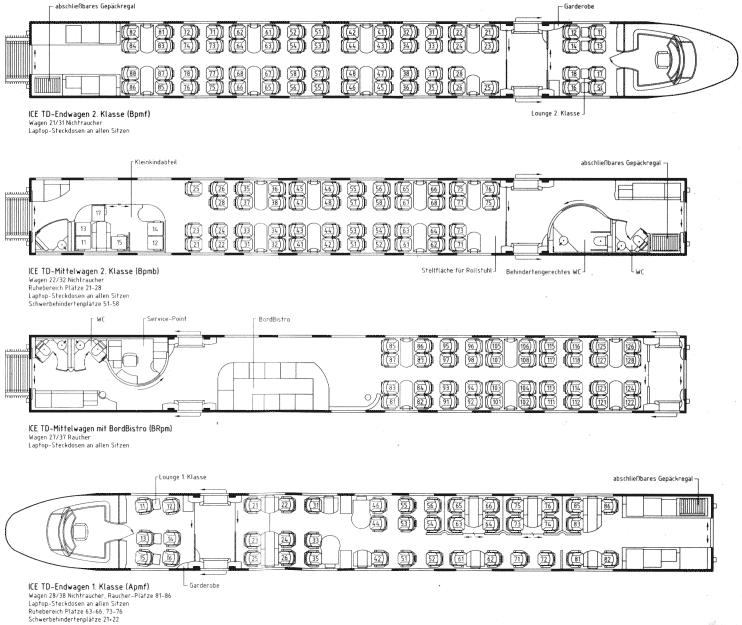VT - tilting InterCity DMU (Class 605) (original) (raw)

There are still some non-electrified lines with long distance passenger trains which are in need of being speeded up. For these lines, a Diesel version of the ICT is currently being developed. 20 trains have been ordered in 1996 and were delivered from 1999 to 2001. With 200 km/h regular top speed, this are the fastest Diesel trains in Germany.
This project was originally called ICT-D or ICT-VT (VT = Verbrennungstriebwagen), meanwhile the name ICE-TD is heard as well.
Appearance
The ICT-VT looks almost the same as the ICT, except that it has only four cars and of course no pantograph on the end cars, instead an exhaust stack on each car and resistor grids (for the electric brake) on the end cars.
Train composition
Each car has a Diesel engine and two traction motors.
| Class | description |
|---|---|
| 605.5 | cab, 1st class (41 seats) |
| 605.2 | 2 WC, crew compartment, galley, 2nd class (40 seats) |
| 605.1 | family compartment (6 seats), 2nd class (45 seats), wheelchair space, 2 WC |
| 605.0 | 2nd class (63 seats or 48 seats + space for 10 bicycles), cab |
Interior
The interior of the ICT-VT is almost identical to the ICT. However, as the ICT-VT is shorter, it has no restaurant or bistro, but only a galley for meal service at the seat, with a small snack counter. Following the experience with the cab cars of push-pull InterCity trains with locomotives, 15 seats in the 2nd class end car can be removed to have space for 10 bicycles.
Ground plans of the ICT-VT (class 605)
1. end car
1st class with observation lounge
2. middle car
2nd class with galley/bar
3. middle car
2nd class with family compartment and wheelchair space
4. end car
2nd class with observation lounge

Drive concept and tilting system
While the ICT-VT is very similar to the ICT for the passengers, it has some technical differences. Every car has an underfloor 560 kW Diesel engine (Cummins QSK 19-R 750) and two self-ventilated 225 kW 3-phase AC traction motors which, unlike in the electric ICT, are situated in one bogie. The four Diesel engines are powering 3-phase AC generators, the rectified current is feeding a DC circuit going through the entire train. The DC is then converted into 3-phase AC by two water-cooled GTO inverters, each supplying four traction motors.
The tilting system, developed by Siemens and SGP, works now electro-mechanically (instead of the hydraulic system used on the electric ICT). The maximum tilt angle is 8°. This system has been successfully tested in one experimentally rebuilt train of class 610.
The train has electric brakes on the powered axles (with resistor grids on the middle cars) and disk brakes on all axles, as well as magnetic rail brakes for emergency braking.
One very interesting option is the addition of a (non-powered) transformer car (with pantograph) that would turn the ICT-VT in a hybrid train, which could switch off its Diesel engines on electrified lines and work from the overhead wire. However, this is just an option, trains equipped like this have not yet been ordered.
Technical data
| end car | middle car | train | |
|---|---|---|---|
| length | 27.45 m | 25.9 m | 106.7 m |
| bogie distance | 19 m | ||
| axle distance | 2.6 m | ||
| mass | empty: ~ 214 tfull: ~ 232 t | ||
| power (traction) | 1700 kW | ||
| power (total) | 2240 kW | ||
| top speed | 200 km/h | ||
| seats (1st class): | 41 | ||
| seats (2nd class): | 154 | ||
| weight/length | ~ 2.01 t/m | ||
| seats/length | 1.83 seats/m | ||
| weight/seat | ~ 1.1 t/seat | ||
| power/weight | ~ 7.95 kW/t | ||
| power/seat | 8.72 kW/seat |
ICT-VT lines
It was planned to start operating the first lines in 2000, but there were huge delays, partly because of technical problems (mostly with the brakes), partly because the lines were not equipped for tilting trains fast enough. So there are still no public ICT-VT, but the trains can often be seen in test runs on the lines where they will operate in the future.
On 2001-06-10, regular service will start at last on two lines:
- Dresden - Hof - N�rnberg, one train every two hours.
- M�nchen - Lindau - Z�rich, replacing at first one_EuroCity_.
Since 2001-04-23, the first regular operations of class 605 have started. The following connections are run with double sets of class 605:
- ICE 1561 KARL SCHMIDT-ROTTLUFF Zwickau 5:30 - Chemnitz 6:12/14 - Dresden Hbf 7:30
- IR 1568 RUDOLF DIESEL Dresden Hbf 9:57 - Chemnitz 11:26/29 - Hof 13:27/28 - N�rnberg 15:21
- IR 1660 GOTTFRIED SEMPER Dresden Hbf 7:57 - Chemnitz 9:26/29 - Hof 11:27/28 - N�rnberg 13:21
- IR 1661 GOTTFRIED SEMPER N�rnberg 12:36 - Hof 14:37/41 - Chemnitz 17:11/13 - Dresden Hbf 18:31
- IR 1663 ROBERT SCHUMANN N�rnberg 14:36 - Hof 16:31/41 - Chemnitz 19:11/13 - Dresden Hbf 20:31
- ICE 1668 KARL SCHMIDT-ROTTLUFF Dresden Hbf 20:15 - Chemnitz 21:27/32 - Zwickau 22:11 The ICE 1561/1668 was previously a single class 415 train, the other trains were previously locomotive-hauled. Until the timetable change on 2001-06-10, they can be used without paying a supplement. Keep in mind, however, that this is an "experimental" service, so these trains might always be replaced by locomotives (class 234) with normal InterRegio coaches.
Models of the ICT-VT
H0
Roco has announced a H0 model of class 605, both for DC and AC, exactly in 1:87 scale, for 2001.
